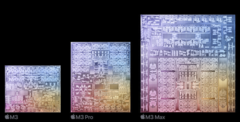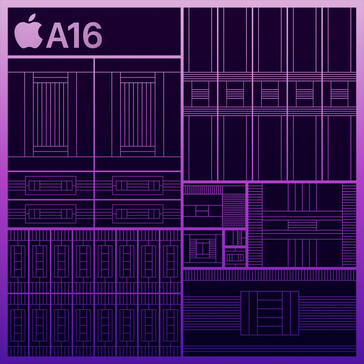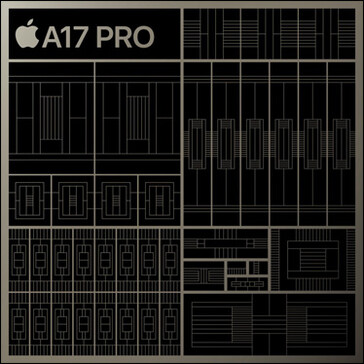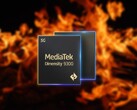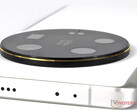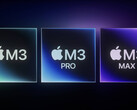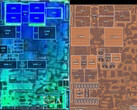In the lead up to the launch of the first Apple silicon chip for Macs, Apple had made it clear that its mobile SoC architecture was “scalable,” meaning they could scale up an iPhone SoC architecture to power MacBooks through to the Mac Pro by building out more CPU, and GPU cores and adding more RAM and so on. When the first M1 Macs were launched, this was apparent when it used the same foundational architecture as the A14 Bionic. Similarly, when the Apple M2 series was launched, it was apparent that it was based on the A15 Bionic.
It hasn’t yet been made clear which of Apple's newer mobile SoCs has been the basis for the new M3 chips, and as Apple doesn’t normally make this public, we’ve undertaken some sleuthing. The M3 chips follow the launch of the A16 Bionic, which powered the iPhone 14 Pro models and, more recently, it comes after the launch of the A17 Pro, which is powering the new iPhone 15 Pro models. Of the A16 Bionic and the A17 Pro, only the latter has been fabricated using TSMC’s new 3nm node (N3B), just as the new M3 series. However, there are some clues that suggest the M3 also has a lot in common with the A16 Bionic - perhaps more so than might meet the eye.
One aspect of the provenance of the M3 design that is crystal clear is that it shares the same, or very similar, GPU architecture to the A17 Pro. Apple calls the A17 Pro graphics “the biggest GPU redesign in Apple’s history,” while it says the M3 graphics “represents the biggest leap forward graphics architecture ever for Apple silicon.” With the A17 Pro launched on 13 September and the M3 chips launched on 31 October, it is safe to assume the architecture is going to be very similar, especially given the brand new hardware accelerated ray tracing feature is common to the two. The only exception may apply to the “Dynamic Caching” feature in the M3 GPU that wasn’t called out as a feature of the A17 Pro GPU. Otherwise, the A17 Pro and M3 GPUs share much more in common than do the A16 Bionic's GPU and the M3 GPU.
Things change, however, when we look at the M3 series NPU (Neural Processing Unit). As in previous M series chips, the M3 “Neural Engine” (as Apple calls it), has 16 cores and produces 18 TOPS (trillion operations per second). This is almost 2x slower than the NPU in Apple’s latest smartphone chip, which is somewhat unexpected. The NPU in the Apple M1 is good for 11 TOPS (the same as the NPU in the A14 Bionic), while the NPU in the Apple M2 was 15.8 TOPs (the same as the NPU in the A15 Bionic). As you might have guessed, the NPU in the M3 is much closer to the NPU in the A16 Bionic’s 17 TOPS, indicating that this is the basis for the M3 series NPUs. The 1 TOP differential can be explained by the performance gained through the switch to the 3nm node used for the M3 against the 5nm (N4P) node used for the A16 Bionic. Or it could simply be the result of a clock boost.
As for the CPU architecture, that is a little more difficult to discern, but there is a very good case for it to be made that it is more likely to be in line with the A16 Bionic. While the shared NPUs is one clue that the CPU architecture is also the same, the next-generation GPU architecture that we have now seen debut on the Apple A17 Pro and M3 series was actually originally intended for the A16 Bionic. An exclusive report [sub.req] from The Information in December of 2022 said that Apple’s engineers were “too ambitious” with this ray tracing-capable GPU. Prototype A16 Bionic chips running the new GPU architecture suffered from overheating and drew too much power. This “unprecedented” blunder came amidst an exodus of top chip talent from Apple, including former A series lead architect Gerard Williams who left to found Nuvia and is now SVP of Engineering with Qualcomm following its acquisition of Nuvia. Williams was recently on stage at Qualcomm’s Snapdragon Summit to launch the impressive M2 Max-beating Snapdragon X Elite chip.
What this is suggestive of is that the M3 series chips were probably intended to be entirely based on the A16 Bionic, including its proposed next-generation GPU. Apple pivoted with the A16 Bionic by improving graphics memory bandwidth to boost performance over the A15 Bionic, but delayed the implementation of the new GPU architecture until the A17 Pro. Apple will have undoubtedly had all the technical documentation and schematics laid out for the M3 with A16 architecture - including the new GPU architecture. However, where they had to rush a fix for the A16 GPU, they would have still had time to get the GPU sorted out as planned for the M3 series, while also making sure it was good to go for the A17 Pro.
Given the M3's NPU connection with the A16 Bionic - and the fact that what was supposed to be the A16 Bionic GPU ended up in the M3 - it seems highly likely that both the A16 Bionic CPU and NPU architecture also form the basis of the M3. Thus, the Apple M3 series looks to be a hybrid of the A16 Bionic and A17 Pro, but an accidental hybrid. It received the CPU, NPU and GPU cores always intended for the chip - just by what looks to be a more circuitous route.
Source(s)
Own


 Deutsch
Deutsch English
English Español
Español Français
Français Italiano
Italiano Nederlands
Nederlands Polski
Polski Português
Português Русский
Русский Türkçe
Türkçe Svenska
Svenska Chinese
Chinese Magyar
Magyar